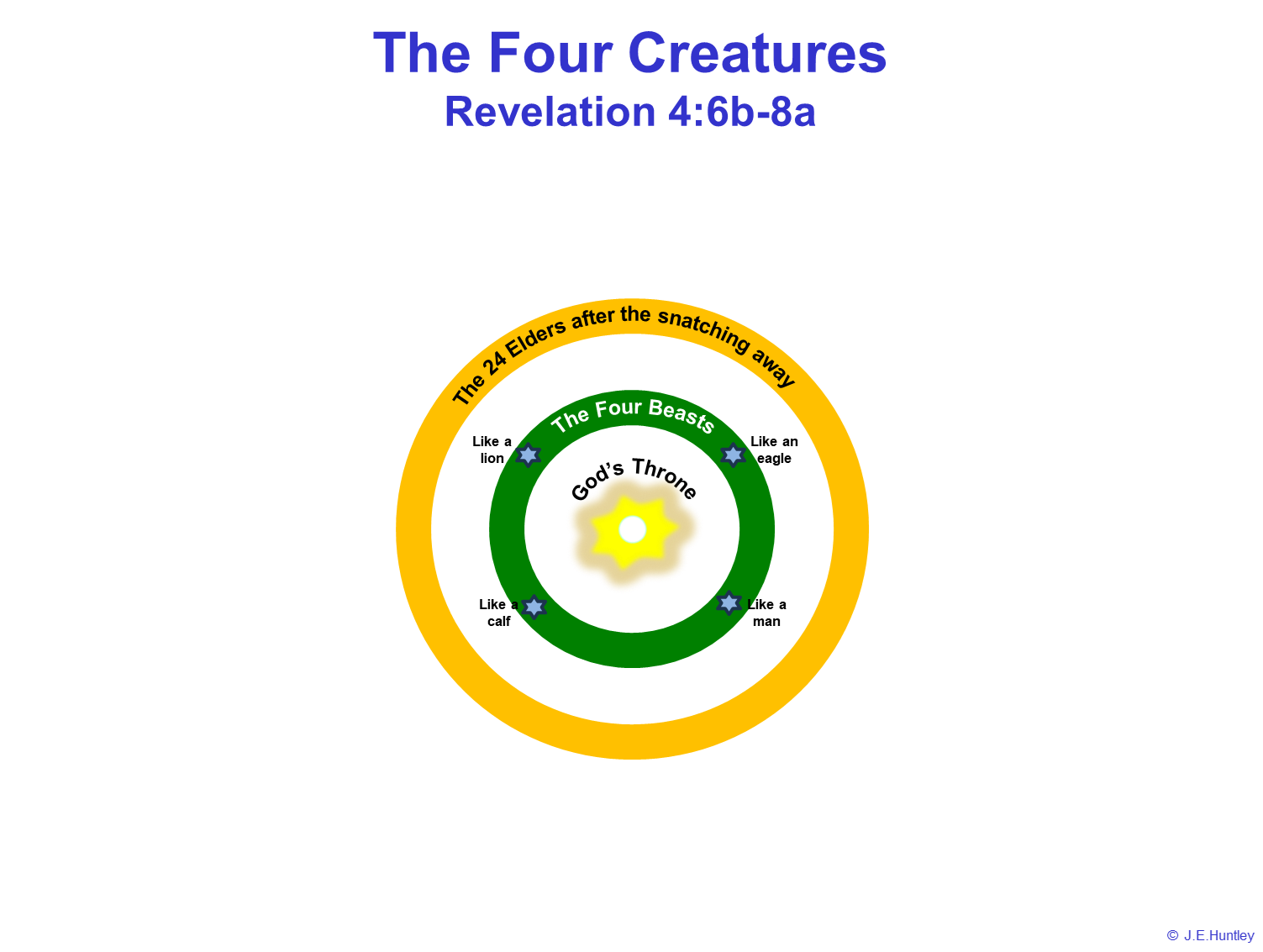Revelation: Chapter 4
Setting
Revelation 4 is a big departure from the previous three chapters. Revelation 1 served as the introduction to the book and revealed to John the glorified Christ among His churches. Revelation 2-3 revealed the instructions the Lord gave to His churches, to show them what they needed to do to be spiritually upright with Him, to be His faithful saints by believing and confessing that He is their Messiah, and thereby prepare them for the tribulation. However, what remains common with the previous chapters with Revelation 4 and 5, is that all these activities occur during the pre-tribulation period.
Concerning John’s visual perspective as he reported on what he saw, the chart chronology of Revelation, reflects that John's viewpoint is in heaven near God's throne in Revelation 4. Revelation 4 and Revelation 5 break from the previous chapters because of John’s vantage point. A new phase in the events concerning the saints has shifted, beginning with several occurrences before the throne of God. The events in this chapter describe the great glory of the throne of God and all the characters and activities surrounding it.
| Verses | Topic |
|---|---|
| 1-2 | After these things, before the throne of God |
| 3-6a | The appearance, order and events before the throne |
| 6b-9 | The four creatures |
| 10-11 | The 24 elders |
In Revelation 1:11, 19, the Lord instructed John to write the things that he had seen (his witness of Christ's first advent), the things that are (the New Testament church age), and the things which will be hereafter (the tribulation, millennial reign of Christ, and the future eternity). Three distinct periods are given by the Father, Revelation 1:1, Acts 1:6-7, that concern Israel, the church, and the tribulation saints. The first period is related to the time that John observed and participated in the Lord's earthly ministry, 1John 1:1-4. The second period is the church age, to whom this book of Revelation has relevance, 2Timothy 3:16-17. Each of the letters to the seven churches in Asia Minor provides the Lord's view of the character of each Messianic church and church type that immediately form after the snatching away (rapture) of the New Testament church. The final period, which indicates a future event relative to the pre-tribulation period, is the transition into the opening of the seven years of tribulation.
The phrases "After this" and "hereafter" in Revelation 4:1 are the exact Greek words used in Revelation 1:19. It reinforces the event of the church being snatched away (raptured), before the things "hereafter". Those things, "After this" and "hereafter," constitute many events to occur during the period known as the tribulation. As identified in the Blue Letter Bible, blueletterbible.org, the words "After this" and "hereafter" are translated from the Greek words, Meta Tauta. The reader is referred to the foregoing link to read more on the meaning of these words in the original Greek. In general, the sense of these words is:
- Meta is defined as either “with”, “after”, or “behind”
- Tauta is defined as “these”
The Lord provided all the information the churches needed to be spiritually prepared for the tribulation, Luke 21:19, Revelation 13:10. ‘The things which shall be’ details to the tribulation churches on what the tribulation is, how long it will last, the events that will occur, the progression of judgments and when the Lord will return the kingdom. A graphical representation of the Lord’s overall plan for His churches is shown at: Church Summary, the survey of God’s overall plan for the New Testament age.
In Revelation 4:1, 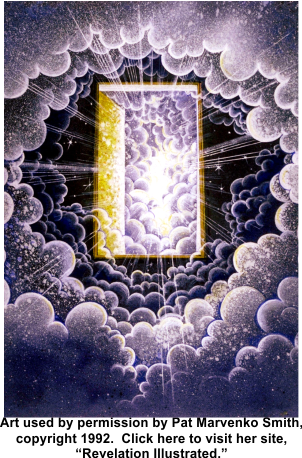 immediately after the preparation of the tribulation churches through the seven letters, several events begin to take place in rapid succession, which will reveal to John what must take place before the Lord Jesus returns to rule over the earth. John observed a door standing open in heaven and heard a voice speaking to him like a trumpet, saying, "Come up here." This is the same description of the sound that John heard in Revelation 1:10, which was the voice of the Lord commanding John to write this book for the seven churches. Similarly, after the two witnesses who were killed by the Antichrist, and lay dead for 3 days, a thundering voice also told them to "Come up here" and immediately they were taken up into heaven, Revelation 11:11-12. John reports that after writing the seven letters and seeing the open door, he heard the Lord’s voice as before, Revelation 1:10, and immediately John was before the throne of God. The experience of John to this point is not dissimilar to the experience the New Testament church will have at the snatching away (rapture); it will be sudden, the believer’s bodily response will be involuntary, but responsive to the Lord’s call, and the translation to eternal bodies will be immediate. More information can be found on this site concerning this subject at: the snatching away (rapture). The events following the New Testament church age were revealed to John and are enumerated from Revelation 4 through the end of Revelation.
immediately after the preparation of the tribulation churches through the seven letters, several events begin to take place in rapid succession, which will reveal to John what must take place before the Lord Jesus returns to rule over the earth. John observed a door standing open in heaven and heard a voice speaking to him like a trumpet, saying, "Come up here." This is the same description of the sound that John heard in Revelation 1:10, which was the voice of the Lord commanding John to write this book for the seven churches. Similarly, after the two witnesses who were killed by the Antichrist, and lay dead for 3 days, a thundering voice also told them to "Come up here" and immediately they were taken up into heaven, Revelation 11:11-12. John reports that after writing the seven letters and seeing the open door, he heard the Lord’s voice as before, Revelation 1:10, and immediately John was before the throne of God. The experience of John to this point is not dissimilar to the experience the New Testament church will have at the snatching away (rapture); it will be sudden, the believer’s bodily response will be involuntary, but responsive to the Lord’s call, and the translation to eternal bodies will be immediate. More information can be found on this site concerning this subject at: the snatching away (rapture). The events following the New Testament church age were revealed to John and are enumerated from Revelation 4 through the end of Revelation.
In Revelation 4:2, John reports that after hearing the voice that sounded like a trumpet, he suddenly was in the spirit and appeared before the throne and in front of Him who sat on it. John had to be in the spirit since God had warned Moses that death would result if anyone in the flesh cast their eyes upon the Lord's face, Exodus 33:19-20. However, the Lord did reveal Himself to Moses by protecting him in a cleft in the rock, and the hand of God shielded Moses from seeing God's face. Moses witnessed God's afterglow, heard God proclaim His name, and announced His mercy and compassion on whom He wills, Exodus 33:19-23. What John saw in the spirit was truly incredible. John's reaction is not given immediately, as he is busy recording all that was revealed. Not only does he see God on His throne, but all the activity and beings about the throne are also captured with John's pen. 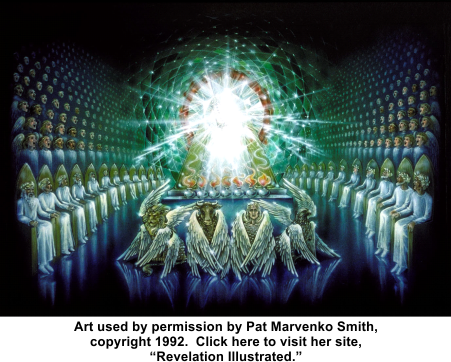
It is instructive at this time to see the other references to the throne of God as reported by the prophets of the Old Testament: Moses, Isaiah, Ezekiel, and Daniel.
In Exodus 24:8-11, Moses records the events that occurred when he and other elders of Israel observed the throne of God. After offering the blood of the covenant that the Lord made with Israel before Mount Sinai, Moses, Aaron, Nadab, Abihu, and seventy elders of Israel went partway up the mountain. They saw the God of Israel, and under His feet was pavement like sapphire, clear as the sky to see through. While there, Moses and everyone with him ate and drank before the Lord, which is common for some of the sacrifices that would be identified in further revelations of the law.
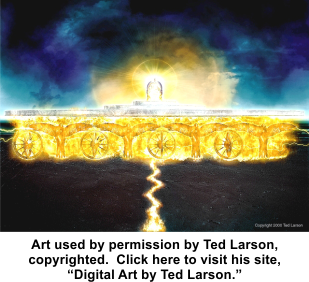 In Ezekiel 1:1-28, Ezekiel 2:1-10, and Ezekiel 3:1-27, Ezekiel recorded a vision that he had by the Kebar River during Israel's Babylonian exile. This is when Ezekiel received his commission from the Lord to be a prophet to the exiles of Israel, Ezekiel 2:1 through Ezekiel 3:15. Concurrently, Jeremiah was with the remnant in the land of Israel, and Daniel was with those who were in the king's house after King Nebuchadnezzar’s first invasion of Israel. In Ezekiel 1:22, Ezekiel observed an expanse sparkling as ice above the heads of the living creatures, leaving him in awe. Then, in Ezekiel 1:23-28, He saw the living creatures associated with this expanse, their behavior, and the mighty sound of their wings. He also heard the voice above the expanse. Ezekiel saw that the throne was of sapphire, and above the throne was a figure like a man, glowing and full of fire, with brilliant light surrounding him, and a rainbow surrounded His appearance.
In Ezekiel 1:1-28, Ezekiel 2:1-10, and Ezekiel 3:1-27, Ezekiel recorded a vision that he had by the Kebar River during Israel's Babylonian exile. This is when Ezekiel received his commission from the Lord to be a prophet to the exiles of Israel, Ezekiel 2:1 through Ezekiel 3:15. Concurrently, Jeremiah was with the remnant in the land of Israel, and Daniel was with those who were in the king's house after King Nebuchadnezzar’s first invasion of Israel. In Ezekiel 1:22, Ezekiel observed an expanse sparkling as ice above the heads of the living creatures, leaving him in awe. Then, in Ezekiel 1:23-28, He saw the living creatures associated with this expanse, their behavior, and the mighty sound of their wings. He also heard the voice above the expanse. Ezekiel saw that the throne was of sapphire, and above the throne was a figure like a man, glowing and full of fire, with brilliant light surrounding him, and a rainbow surrounded His appearance.
In Isaiah 6:1-13, the prophet Isaiah described his vision concerning the Lord's throne and the commission he received. In Isaiah 6:1, Isaiah observed the Lord seated high and lifted up. The train of the Lord's robe filled the temple. In Isaiah 6:2-4, he reported seeing seraphim above the Lord. Each of them had:
- Two wings covered their face
- Two wings covered their feet
- Two wings were used for flying
- They called to one another the praises of God
- As they cried out, Isaiah witnessed the door posts move at their sound
Then Isaiah saw the whole house filled with smoke. In Isaiah 6:5-7, the prophet Isaiah reported being undone at this marvelous sight, and he recognized and confessed his uncleanliness and that of Israel. Thereafter, a seraph flew to Isaiah, and taking a piece of hot coal from the altar, he touched Isaiah's lips with it. Next, Isaiah was told that his iniquity was taken away, and his sin purged. Isaiah 6:8-13 shows the commission of Isaiah from the Lord to go to the people of Israel and tell them God's words. However, Isaiah was warned that the message would not be immediately understood or accepted, but Israel would receive God's blessings after much time.
Before continuing with the description of what Daniel saw, exploring some of what John observed may be helpful. Afterwards, Daniel's vision will be compared with that of Moses, Isaiah, Ezekiel, and John.
In Revelation 4:3, it is stunning how John describes the appearance of God sitting on His throne. John saw God's appearance as if it were jasper and sardine. God's interaction with His people is seen in the colors selected, such as the 12 gems used to decorate the high priest's breastplate, with the names of each tribe on them, Exodus 28:15-21, 39:8-14. The firstborn was Reuben, who would have been represented by the sardius stone on the high priest’s breastplate, and the youngest was Benjamin, represented by the jasper stone. John saw Benjamin’s color first and Ruben’s last if the assigned colors remained true. Benjamin was also the first to be born in the promised land. The colors also appear in the makeup of the New Jerusalem, Revelation 21:9-11. John also saw a rainbow resembling an emerald encircling the throne.
The first and last stones resemble the entirety of the tribes of Israel. These two stones encompass His lasting covenants and promises of God and His love for them. For the remembrance of these with Israel, God acted in His time to free Israel from Egypt’s bondage, Exodus 2:24. He will again remember all that was promised to Israel, when the time He set arrives, and He will restore Israel in His coming kingdom, Acts 1:6-7. Likewise, with the emerald rainbow about His throne, the rainbow was not to remind God of His covenant with man and every living creature not to destroy the world with water again, Genesis 9:12-17. It was to show all creation that His Word is true and everlasting. The future world judgment will not be caused by a worldwide flood but by fire. This rainbow was not an arc, as seen today from Earth’s surface, but a full circle, representing perfection and completeness in God’s judgment. The color emerald relates to the Earth. The judgment that John the Baptist warned the religious leaders of Israel about was the baptism of the Holy Spirit (which happened in Acts 2), and fire, which is the tribulation, Matthew 3:11.
John is a first-century man, tasked to describe future events in a way that communicates with our modern time, an extraordinary feat. Still, he also describes heavenly things and God Himself. Likewise, when addressing Nicodemus’ surprise concerning being born again, Jesus told him that if he could not understand the earthly things, how could he know heavenly things? No man ever ascended to heaven, but the Son of man came down from heaven, John 3:9-13. Paul also described his experience in heaven. Paul, who died from stoning at Lystra on his first missionary journey and was raised from the dead, Acts 14:19-20, wrote of his experience in heaven, 2Corinthians 12:2-5. He was not allowed to repeat what he heard; that was left to John in Revelation to report.
In Revelation 4:4, John noted an order around the throne of God. Twenty-four elders sat on thrones surrounding God's throne. Their position relative to His throne implies their importance to God, but more importantly, they are mentioned first. They were dressed in white and wore gold crowns. Some commentators believe that the elders are angels, others suggest they represent the 12 tribes of Israel and the 12 apostles, and some think they signify the raptured church. The following graphic simply depicts the 24 elders' location around the throne. Its purpose is to illustrate the position of groups of people and heavenly beings as they appear in God’s throne room. As John writes in this book, this graphic will evolve as revelations occur.
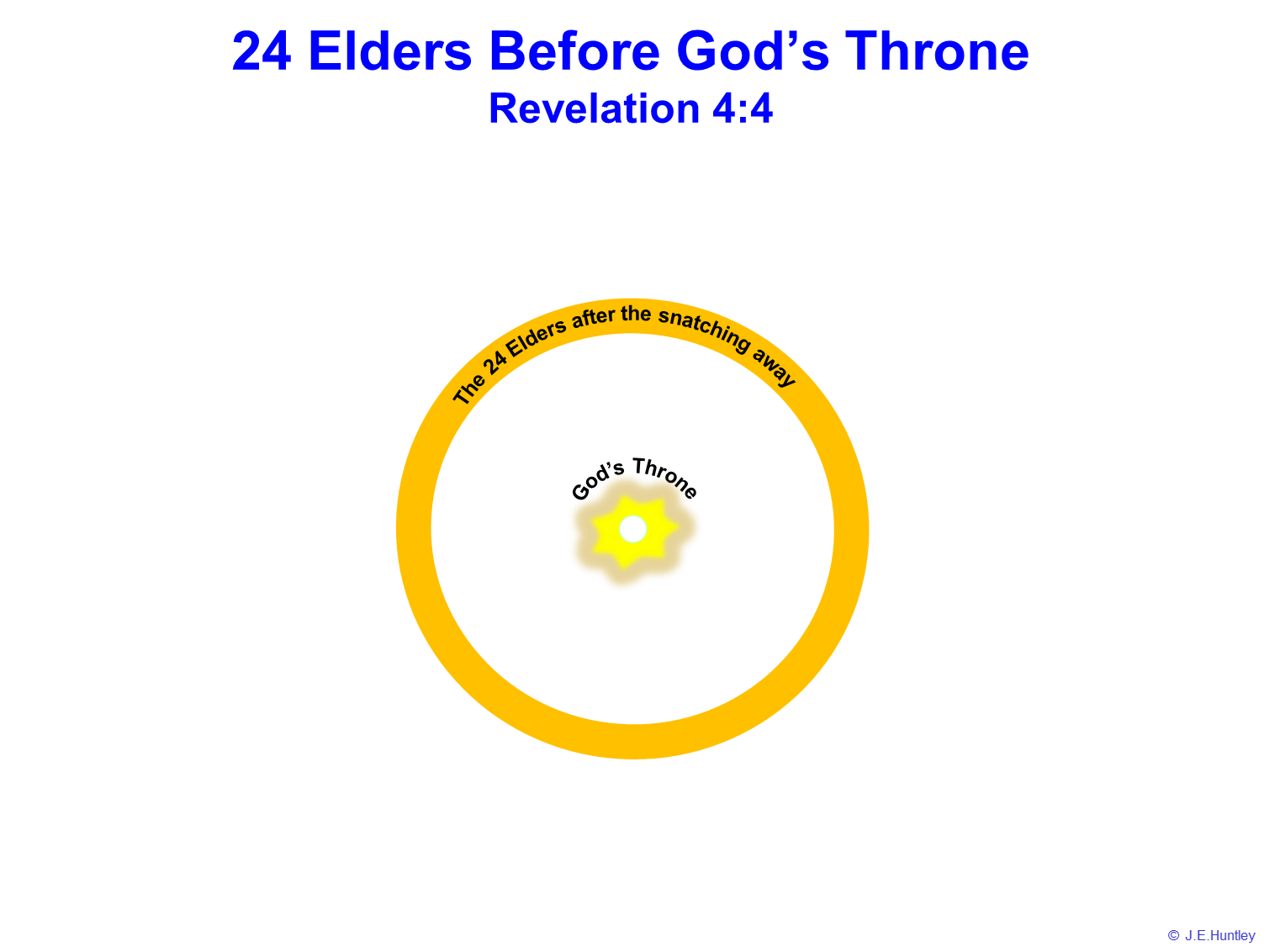
The identity of the 24 elders is not explicitly given, but their conduct and dress may provide some clues as to who they are. First, why could they not be angels? One reason is that these elders are wearing crowns, promised to the New Testament church saints, 1Corinthians 9:24-27, James 1:12, 1Peter 5:4. Also, each group identified in Revelation, the saints, angels, and the tribulation saints, all have their own song in the book of Revelation, which is unique to that group.
Second, the song in this chapter is sung by the redeemed in Christ. Neither the angels nor the tribulation saints who will be introduced to John in Revelation 6:1-17 participate in this song. It would appear that the elders represent only the church, not the angels or tribulation saints.
Third, why do the elders not represent the 12 tribes of Israel and the 12 apostles? There are certainly some interesting arguments for thinking so. Near the end of this book, in Revelation 21:10-14, the new Jerusalem is described as having 12 gates named after the tribes of Israel and the 12 foundations after the Apostles. Another reason is the logical division of 24 being evenly divided into two parts of 12, one for the tribes of Israel and the other for the 12 apostles. This is one of the issues raised in this book of the Bible, where today one cannot be dogmatic about a conclusion. Thinking that the elders represent the 12 tribes of Israel and the 12 apostles may be correct, but there is yet another possibility.
Fourth, the 24 elders may represent the New Testament church that was snatched away (raptured) for the following reasons:
- At this moment in this developing narrative revealed to John, only two groups have been resurrected or snatched away (raptured)
- The first were many Old Testament saints, raised after Jesus was raised from the dead, Matthew 27:52-53
- They were the wave offering for the feast of firstfruits in heavenly places, Leviticus 23:10-11
- The second group that will have been taken up are those in the New Testament church at the snatching away (rapture)
- The New Testament church has two components: the Jewish church, led by the 12 apostles, which began in Jerusalem, and the second component was the Body-of-Christ that Paul led, Galatians 2:7-9
- Twelve elders could be from the Jewish church, and the other 12 from the Body-of-Christ
- The Body-of-Christ is composed of Jews and Gentiles, which could also account for the 12 and 12 groupings, one representing the Jews and the other representing the Gentiles, Galatians 3:28-29
- The Lord ordered His church to have elders and deacons, etc., Acts 14:21-23
- When we are in the Lord's presence, we will be like him, 1John 3:1-3
- Paul may be here, honored as an apostle to the Gentiles, since he was not one of the 12 apostles, Rom 11:13, Gal 2:8, 1Tim 1:15-16
- All the remaining Old Testament and tribulation saints will be resurrected after the Lord’s literal, physical, and visible return to sit on David’s throne at the end of the Armageddon, Daniel 21:1-3, Revelation 20:4
As a result, it is thought, but not strongly held in light of the third alternative, that the New Testament church is more likely the source for the elders.
Returning to the description of God's throne room, in Daniel 7:9-11, 13-14, the scene is not during the days of Daniel, but is prophetic and coincides with Revelation 4 and Revelation 5. The appearance of God's throne room is set up first with all the thrones in array for the judgment of the indescribable beast that Daniel sees in Daniel 7:7-8. The following action that Daniel observes is the "Son of Man" coming with the clouds of heaven to approach the Father and to be given all dominion over the entire world. This is precisely how the Lord answered Caiaphas, the high priest, the night Jesus was betrayed. When the high priest asked Jesus if He was the Christ, the Son of the Blessed One, Jesus replied that He was. He also told all present that they would see Him, the Son of Man sitting on the right hand of power, and coming in the clouds of heaven, Mark 14:61-63.
What is missing from the previous visions concerning God's throne as recorded by Moses, Isaiah, and Ezekiel? First, in other records, only God and the seraphim are seen, and the temple is filled with God's glory; no other being is seen in God's throne room. Daniel mentions two groups in his vision: those who attended the Lord (thousands upon thousands), and those who stood before Him (ten thousand times ten thousand). This may not be an absolute number, 100,000,000, to serve as a limit of those who make up the snatched away (raptured)New Testament church and bride of Christ, but rather it may be indicative of a vast number of the saints and their proximity to God before His throne. A court was seated before the throne of God, and the books of judgment were opened, 1Corinthians 6:1-4. It is the position of this website that the events in Daniel 7:13-14 relate to the events as they unfold in Revelation 5:1-14.
To return to John's observations, in Revelation 4:5, he saw and heard from the throne flashes of lightning, rumblings and peals of thunder, which Moses also observed as they waited upon the Lord at the base of Mount Sinai, Exodus 19:16-19, and what David wrote about in a psalm, Psalm 18:6-15.
John also saw seven lamps representing the Holy Spirit before the throne, Isaiah 11:1-2, John 16:13-15, Zechariah 4:2, 6, 8-10. These are:
- The Spirit of the Lord
- The Spirit of Wisdom
- The Spirit of Understanding
- The Spirit of Counsel
- The Spirit of Power
- The Spirit of Knowledge
- The Spirit of the fear of the Lord
These are not separate entities, but the different manifestations of the Holy Spirit.
Finally, in Revelation 4:6, there was what looked like a sea of glass before the throne, clear as crystal. Again, commentators offer many interpretations concerning the sea of glass, such as the aggregate church at rest. However, consider the other instances of the temple, seen by Moses as pavement-like sapphire that was as clear as the sky to see through, and by Ezekiel as an expanse sparkling like ice and awesome. In light of these observations, the sea of glass may represent the "bigness" of God.
In Revelation 4:6-7, John sees around the throne four living creatures who are closer to the throne of God than the other groups. The following graphic illustrates the position of the creatures relative to God’s throne.
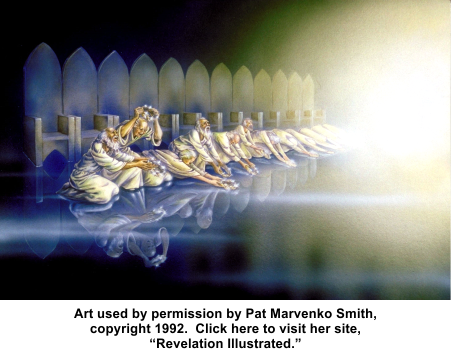
John described the four creatures' characteristics as:
- Being covered with eyes in the front and back
- One is like a lion
- The second is like an ox
- The third is like a man
- The fourth is like an eagle
- Having six wings that were also covered with eyes
- Giving continual praises to God, day and night
Finally, the Lord is described as the one who opens and no one can shut, and what He shuts no one can open.
A further description of these creatures is given by Isaiah, Isaiah 6:2. This is where Isaiah described the creatures around the throne. Above God the Father were seraphs with two wings that covered their face, two wings that covered their feet, and two wings that were used for flying. They called to one another the praises of God.
In Ezekiel's description, he saw them along with wheels in Ezekiel 1:4-24. These creatures are different from what is described by John in Revelation 4:1-11, and serve other functions, but there are similarities as well with what John reports.
Some have associated these four beasts with the four gospels and other parts of scripture; see the following table. The Gospel according to Matthew presents the Lord as the King, the Lion of Judah, as represented in scripture. The gospel according to Mark presents the Lord as the willing servant, the ox. The gospel according to Luke presents the Lord as the man who is one of the four beasts. The Gospel of John presents the Lord as the Son of God, which an eagle represents. These beasts provide John's views on earth that show the impact of each seal the Lord opens in Revelation 6:1-17.
| The Beast's likeness | Associated With | Related to the Gospel of: | Represents the Lead of a Triad of Israel's Tribes | Location of the Tribe Around the Tabernacle During the Exodus |
|---|---|---|---|---|
| Lion | King | Matthew | Judah | East (right side) |
| Ox | Servant | Mark | Ephraim | West (left side) |
| Man | Man | Luke | Ruben | South |
| Flying Eagle | Deity | John | Dan | North |
In Revelation 4:8, John observes each of the four living creatures about the throne of God continually singing:
Holy, holy, holy is the Lord God Almighty, who was, and is, and is to come
They cry out Holy three times in recognition of the triune nature of God: the Father, Son, and Holy Spirit. They also praise God for His eternal nature and the Son establishing His throne on the throne of David on this earth. The Lord will be taking back dominion over this world that Adam lost to Satan in the Garden of Eden.
In Revelation 4:10-11, John views the continuing praises toward God. Whenever the creatures cry out their praises to God, the elders respond:
- They fall down before God
- They worship God
- They lay their crowns before Him
- They sing out as well
Their praise and that of others about the throne continue through Revelation, with the same or parts of what is expressed here:
- Worthy
- Glory
- Honor
- Power
- For He has created all things and for His pleasure they were created
For the saints, this is nothing less than joy unspeakable, 1Peter 1:3-8! This song of the four living creatures and the 24 elders is the first of seven songs recorded by John throughout the remaining chapters in Revelation. The other songs are sung by other groups as well.
Finally, it is thought that these 24 elders represent the New Testament church. John will introduce another group of saints in Revelation 6:9-11, and a third group in Revelation 7:9-17. These two groups consist of the slain saints during the tribulation and the great tribulation, the last 3 1/2 years of the tribulation. Note the difference between these last two groups with the group representing the church; the latter two groups are dressed in white, which is the righteousness of Christ, but they do not have the crowns that were promised to the church. This is another powerful reason for seeing that the church is raptured before the beginning of the tribulation.

